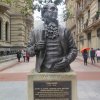I have read this thread with interest. My two-cents worth is that "construction" of a "Camino Americano" might be feasible if the route mentioned above were REVERSED so that the beginning was in Paris, let's state Notre Dame for consistency, and so that the end point was Santiago. There would have to be historically based alternative starting points, so that folks not having two months or more to walk from Paris could still do this route.
For a Camino to be part of the
Camino de Santiago "network," per se, the end must be at the Apostle's tomb, the Cathedral. The "official" marker designating the end point is at the center of Plaza Obradoiro, immediately in front of the Cathedral. Still, this route has significant political and historical value, mostly to US citizens.
All in all, it might be interesting to cobble this route together using a combination of French routes Grand Randonee (GR) and the various established routes already acknowledged as being part of the
Camino de Santiago system or network of routes, all terminating at Santiago.
I hope this helps.




















